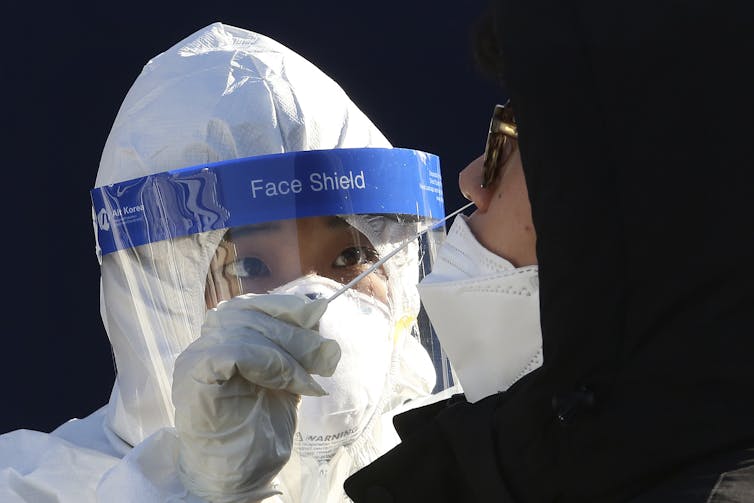
dusanpetkovic/iStock via Getty Images Plus
C. Michael White, University of Connecticut and Adrian V. Hernandez, University of Connecticut
Going into the third year of the pandemic, public health experts are developing strategies to work within communities to have a more nimble and rapid response to COVID-19 infection rates.
C. Michael White, a professor of pharmacy practice, and Adrian V. Hernandez, a clinical epidemiologist, both from the University of Connecticut, explain how the Biden administration’s new “test to treat” initiative will make use of pharmacies in this effort. The strategy is to quickly identify those who are positive for COVID-19 and to provide oral antiviral treatments in the early days of illness when it is deemed necessary – all through the easy access of a local pharmacy. And they discuss how the strategy falls short of addressing the needs of underserved communities.
1. What is the premise behind the initiative?
In his March 2022 State of the Union address, President Joe Biden introduced the “test to treat” initiative, a program designed to help reduce barriers to getting COVID-19 treatments in the early stages of illness. The goal is for people to be able to walk into a pharmacy with a health clinic staffed by nurse practitioners, physician assistants or physicians and to be tested for COVID-19 free of charge; if a person tests positive and treatment is deemed appropriate, oral antiviral therapy can be prescribed on the spot at no cost.
The premise is that the sooner people are tested, the sooner they can self-isolate to limit the spread of the disease while simultaneously receiving oral antiviral medications to help prevent hospitalization and death from COVID-19.
2. How might this initiative help curb the next wave of COVID-19?
As of March 31, 2022, more than 1 million out of 332.6 million people or 3 in 1,000 people living in the U.S., have died from COVID-19. In contrast, 16,230 people out of 51.8 million or 3 in 10,000 South Koreans have died from COVID-19.
Some countries, such as South Korea and New Zealand, invested heavily in COVID-19 testing and contact tracing early in the pandemic so those at higher risk of infection could be tested immediately and isolated early. And they implemented contract tracing – the process of identifying friends, family and co-workers who may have come into contact with the infected person – early on to help slow the spread of infection.

AP Photo/Ahn Young-joon
Another advantage of early COVID-19 testing is that infected people can be treated much sooner. A new meta-analysis of oral antiviral therapies found that such treatments reduced the risk of hospitalization and death from COVID-19 by nearly 67%.
Starting therapy early is key. Early studies with the injectable antiviral remdesivir found that people did not benefit from the treatment at later stages of illness. Clinical trials for the newest oral antiviral therapies against SARS-CoV-2, the virus that causes COVID-19, required that patients be treated within five days of the beginning of their symptoms. So combining early testing with immediate access to free oral antiviral therapy could make a huge difference, especially for those with limited access to traditional health care services.
A more rigorous and proactive testing program in the U.S. could especially benefit underserved communities with limited health care access. For instance, in the first half of the pandemic, a study found that for every 10,000 people who tested positive for COVID-19, more than 30 Hispanic patients and nearly 25 Black patients were hospitalized, compared with only 16 Asian patients and seven white patients.
3. What are the limitations of the initiative?
Only about 2,800 of the approximately 50,000 retail pharmacies in the U.S. have health clinics staffed by nurse practitioners, physician assistants or physicians, and about a third of them are located in California, Florida, Illinois, Minnesota and Texas. And only 12.5% of these retail clinics are located in medically underserved areas.
This leaves much of the country, and especially populations who suffer disproportionately from health disparities, left out of the “test to treat” initiative. But 95% of Americans live within 5 miles (8 kilometers) of one of more than 41,000 community pharmacies. If those settings were part of the initiative, access and impact would be much more widespread and equitable. The pharmacy is often the sole health care setting that can alleviate the problem of health care deserts – areas that lack sufficient access to medical offices in inner-city and rural communities.
At the height of the omicron surge, between 890,000 and 904,000 people in the U.S. were diagnosed with COVID-19 daily. Physicians’ offices and emergency departments were highly stressed. So adding only 2,800 retail health clinics – which are also dealing with heavy demands outside of COVID-19 – to rapidly test and disseminate oral antiviral drugs across the nation is unlikely to make a major dent in handling a COVID-19 surge. And there would be virtually no impact on COVID-19 outcomes in underserved communities, which would continue to have limited access.
4. Could pharmacists play a bigger role in the initiative?
Our research shows great variations in how pharmacists are allowed to practice in the U.S. In hospitals across the country as well as federal health clinics run by the Department of Veterans Affairs, Indian Health Service and Department of Defense, pharmacists are fully integrated health professionals who can order lab tests and interpret their results, order or alter drug therapy and actively monitor a patient’s drug response.
The data supporting the positive impact that pharmacist-provided services have on patient health is undeniable. For example, pharmacist-run hypertension and diabetes clinics help patients achieve their blood pressure and blood sugar goals better than the standard treatment provided in physicians’ offices.
But pharmacists are not currently recognized as Medicare Part B providers – health professionals allowed to bill Medicaid for clinical services. So pharmacists are limited in their ability to provide clinical services in the community.
5. What can be done to address access issues?
To broaden access, the Department of Health and Human Services authorized pharmacists to provide COVID-19 vaccines in community pharmacies or long-term care facilities in September 2020. Since that time, pharmacists from more than 41,000 pharmacies have administered 233.4 million vaccine doses as of early April 2022. This includes 46% of all COVID-19 vaccinations in children ages 5-11.
A similar authorization could be granted to allow pharmacists to provide oral antiviral drugs to patients with positive COVID-19 tests who meet the criteria.
[Like what you’ve read? Want more? Sign up for The Conversation’s daily newsletter.]
Alternatively, a bill that has been proposed with bipartisan support in the House of Representatives aims to ensure that all communities have access to testing and drug treatment by a pharmacist.
However, the American Medical Association has taken a stand against “test to treat” in pharmacies, whether or not they have a health clinic with nurse practitioners and physician assistants in them. The organization states that the large number of drug interactions with these antivirals, the complexities of COVID-19 disease and the lack of full access to patients’ medical records suggests that patients testing positive for COVID-19 should solely contact their physician to discuss treatment options.
But this position does not take into consideration the medical conditions pharmacists already successfully manage, such as heart failure and blood clotting. And it does not address how to care for the 25% of patients – largely in underserved communities – who do not have a primary care physician or access to a health clinic within a pharmacy.
C. Michael White, Professor of Pharmacy Practice, University of Connecticut and Adrian V. Hernandez, Associate Professor of Comparative Effectiveness and Outcomes Research, University of Connecticut
This article is republished from The Conversation under a Creative Commons license. Read the original article.















